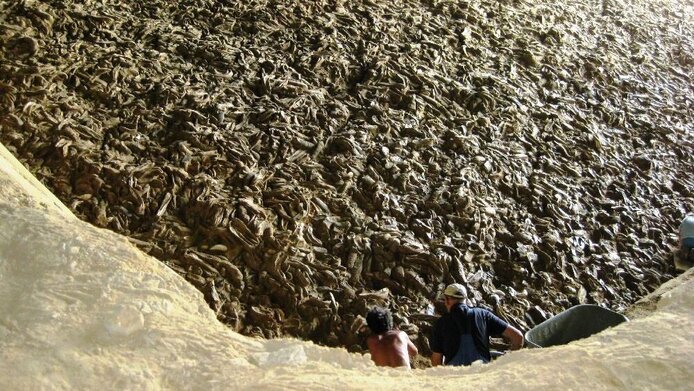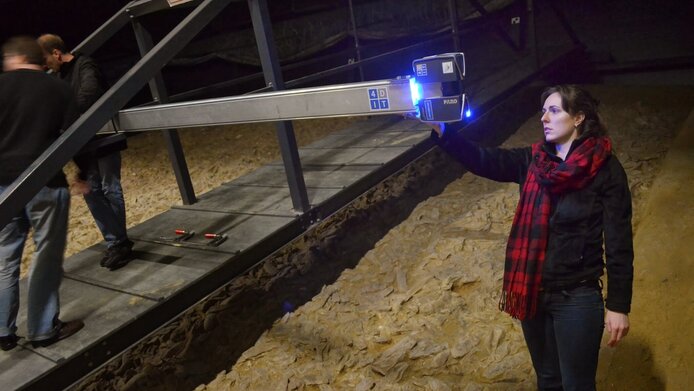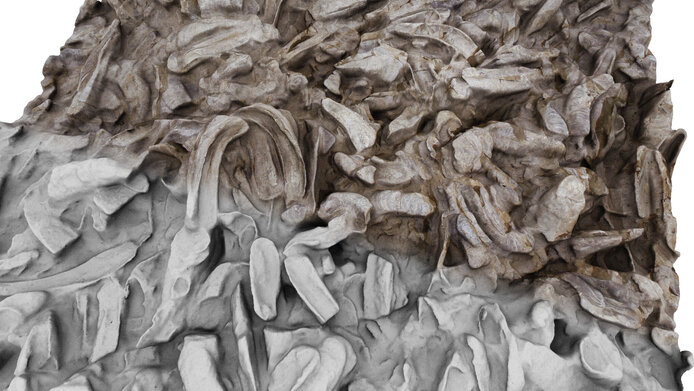Measuring prehistory

The world’s largest fossil oyster shell bed is the prime attraction of the Fossilienwelt Weinviertel geo-edutainment park in Lower Austria. Some 17 million years ago, this spot north-east of Korneuburg was a shallow estuary and home to sharks, manatees and a huge number of giant oysters. No less than 650 different animal and plant species have already been documented at this unique fossil site. But researchers are still trying to find answers to many questions about the history of this exceptional find. In order to gain a better understanding of this snapshot of the Miocene ecosystem (about 23 to 5 million years ago), the Naturhistorisches Museum Wien (Natural History Museum Vienna) joined forces with the Vienna University of Technology and, in 2013, launched the Smart Geology project. This FWF-supported project explores whether and how modern techniques of 3D digitisation, data processing and visualisation can contribute to gaining meaningful insights.
The limits of classical methods
“The size of this protected natural location and the enormous number of individual oyster shells there make classical palaeontological prospection very time-consuming and also subjective”, explains project manager Mathias Harzhauser from the Naturhistorisches Museum. Despite a great number of publications on the flora and fauna of this type of landscape (estuary), analyses of the approximately 50,000 oyster shells are still lacking. The task is made even more difficult by the fact that the excavation site enjoys natural monument status and walking around in it is not permitted.
Smart technologies …
“Our aim is a fully automated recording of objects, which is a complicated process given the irregular shapes and different position angles”, explains the geologist. In order to achieve this objective, the researchers are using novel approaches by linking up methods of 3D reconstruction with digital elevation models used in mining research. Huge laser scanners mounted on a dolly are used to record the shells from above and these data are then used to produce 3D models. First trial measurements with these “smart” technologies proved worthwhile, as the analysis of the digital documentation provided new insights from the site which the researchers have recently published in scientific journals.
… provide new insights
The results show that the oyster biostrome is the result of at least four events, some of which occurred many years apart. The research team was able to conclude this from correlating the distribution and incidence of different species and the analysis of the fragmentation and orientation of oyster shells. “A major storm or tsunami brought together ecosystems that would otherwise have been far apart in time and space”, notes Harzhauser.
Age structure and population
The automated computation of the contour and length of the perfectly preserved shells also enabled the researchers for the first time to look for age structures and population patterns in a fossil oyster reef. The results show that the fossil reef bears resemblance to current – commercially important - reefs of this type of oyster. Using the age data collected in an earlier FWF project, the research team also correlated the length of the shells with their ages. “Despite their unusual size of up to 80 cm in length, the majority was only between three and seven years old”, reported Harzhauser from the ongoing project which runs until 2016. This proves that the oyster reef represents a geological “snapshot” and did not accumulate over many decades.
Environmental conditions
In a further step the team computed the ratio between shell length and volume. In order to do that, several shells of different length had to be completely scanned by a high-resolution scanner to produce 3D models. These data allow the researchers to calculate the annual carbonate production of the oyster, which in turn permits drawing conclusions about the climatic context. “The giant oysters turned out to be as productive as coral reefs and hence were probably significant – albeit widely overlooked – producers of carbonate in habitats that were inaccessible to corals”, says Harzhauser.
Who will find “Romeo & Juliet”?
For the techno sciences, the automated prospection of complex shapes represents a task that is as challenging as it is exciting. With the help of these methods, the palaeontologists can better understand the emergence and dynamics of this unique site. “A particular challenge is what the scientists jokingly dubbed the ‘Romeo & Juliet’ project, an attempt to reunite matching pairs of shells, since the tsunami probably separated all of them”, recounts Harzhauser. The expert emphasises that something that sounds very much like “ivory tower science” has a down-to-earth background with practical applicability in our daily lives. The automatised recognition of irregular shapes, such as treetops in a forest or individuals in a throng of people, is a highly topical field of research.
Personal details Mathias Harzhauser heads the Geological-Paleontological Department of the Natural History Museum Vienna NHM, where one of his research specialities is the communication of geological topics. The palaeontologist is the author of numerous publications and, inter alia, a member of the Commission for Paleontological and Stratigraphical Research on Austria of the Austrian Academy of Sciences. The FWF project “Smart Geology for the World’s largest fossil oyster reef” ends in 2016.
Publications
Disentangling the history of complex multi-phased shell beds based on the analysis of 3D point cloud data: Harzhauser, M., Djuricic, A., Mandic, O., Zuschin, M., Dorninger, P., Nothegger, C., Székely, B., Puttonen, E., Molnár, G., Pfeifer, N., Nov. 2015. In: Palaeogeography, Palaeoclimatology, Palaeoecology, http://dx.doi.org/10.1016/j.palaeo.2015.07.038
Age structure, carbonate production and shell loss rate in an Early Miocene reef of the giant oyster Crassostrea gryphoides: Harzhauser, M., Djuricic, A., Mandic, O., Neubauer, T. A., Zuschin, M., Pfeifer, N. Sept. 2015. In: Biogeosciences, http://dx.doi.org/10.5194/bgd-12-15867-2015
Project website







